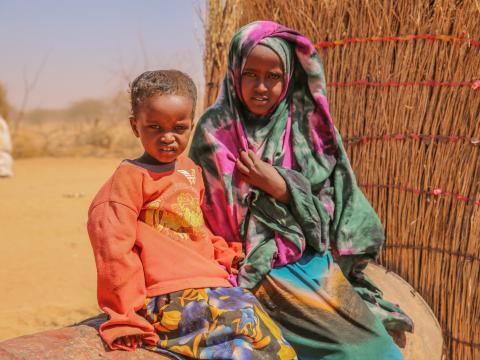World Vision provides life-saving intervention as Somalia is on the brink of famine

Somalia’s landscape has progressively turned drier and dustier over the past months, and with no rain in sight for the second year, rivers have dried up across the country and plants and trees – many people’s only access to food – have succumbed to the scorching sun.
“When my husband passed away, World Vision started supporting me by offering training and providing me with seeds and faming tools.”
Nimo, a 30-year-old mother of two whose husband died several years ago, has watched many of her neighbours leave. “Prices in the markets are peaking and most families have no access to food and clean water. That’s why they leave, in search for a better, more fertile area. I don’t know if they will find it. Often it is more difficult in rural areas to survive and people migrate to the cities,” she explains. “I don’t know what I would do with my family, if we didn’t receive World Vision’s help.”
After two failed rainy seasons, the country is dry and dusty. (Photo by Stefanie Glinski, World Vision UK)
Somalia is on the brink of yet another famine the UN warns, with over 6 million people in need of immediate emergency assistance. And with over 260,000 confirmed deaths after 2011’s famine, many families worry that starvation will kill their livestock, and eventually their children.
When Nimo leaves her house in the mornings, vultures circle over the surrounding brown, empty fields, waiting for yet more animals to die of weakness and thirst. Her bright yellow scarf stands out in the hot, dusty air and the barren fields. Her daily routine starts by walking over to the family’s deep well, start up the small petrol-fuelled pump and water her green patch of vegetables behind her house. Surrounded by dying crops, Nimo’s tiny field is a rare sight.
“Sometimes many people pass by our house with camels. Mum says they are looking for water. It makes me sad.”
“When my husband passed away, World Vision started supporting me by offering training and providing me with seeds and faming tools,” she says. “After two failed rainy seasons, I am still able to provide for my family because of the water pump and education I have received. I am now able to irrigate our vegetable patch.”
Both of Nimo’s children have seen the on-setting drought, but feel secure, knowing they have both vegetables and livestock. Five-year-old Selma, a cheeky girl in a light-blue headscarf and colourful dress often joins her mother on morning walks through the dry landscape and always insists to help water the fields. “I like to drink the fresh water, and the plants like to drink it too,” she says, shyly hiding behind her older brother Abdi.
When she is not claiming to help her mum, she likes to play with an old rag doll, usually sitting in the shade of the small house. Abdi, who is just a year older, sometimes joins in, but he also worries about the rain. “Sometimes many people pass by our house with camels. Mum says they are looking for water. It makes me sad.”
What he doesn’t know is that over 71,000 children in Somalia are severely malnourished and in need of immediate aid, but with a slow start of the drought, global emergency funding has trickled in slowly. As the situation has become more critical, fears of a full famine are undeniable and confirmed by the humanitarian community.
Saîd, a farmer in Somaliland, is desperate because he has lost most of his livestock. He has 14 children and is worried that if his goats keep dying, his children will be next. (Photo by Stefanie Glinski, World Vision UK)
Nimo is just one of the 530,000 people that World Vision has targeted to provided assistance for. “I am happy that my children have food, but I worry about my country,” she says. “It always starts with failed crops, high market prices and dying animals. The suffering and hunger has already started in many parts of Somalia.”
Lean more: World Vision policy brief on the situation in Somalia

